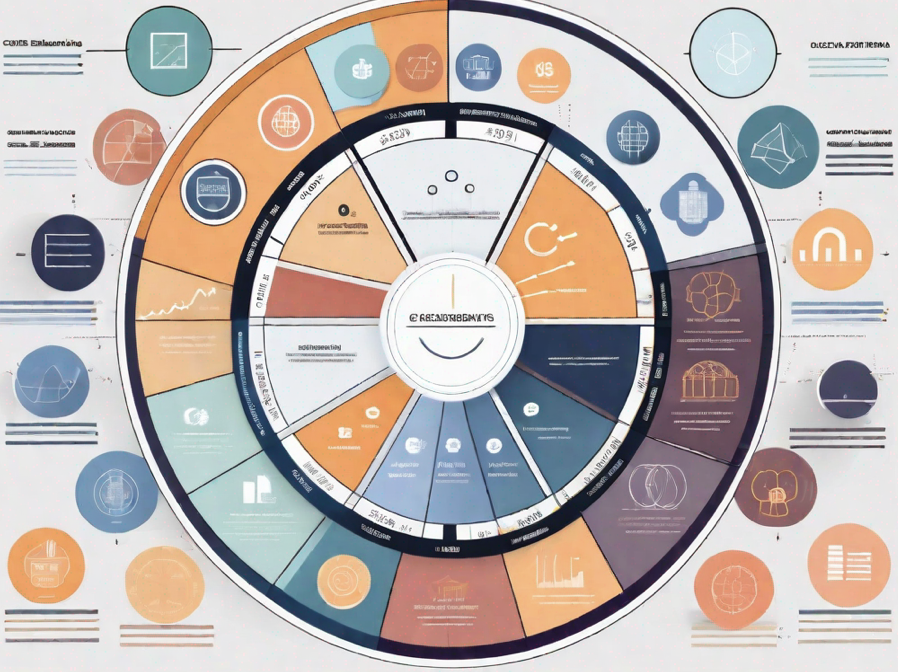Budgeting Strategies for 2024
Budgeting Strategies for 2024
Discover the most effective strategies to optimize your business budgeting for 2024 and ensure financial success.

Managing a business budget effectively is crucial for long-term success. As we enter 2024, it’s essential for businesses to proactively optimize their budgeting strategies to navigate economic uncertainties and achieve financial stability. Businesses can achieve their goals and maximize budgeting efforts by identifying cost-saving opportunities, leveraging automation, analyzing trends, and utilizing real-time data.

Identifying Cost-Saving Opportunities for 2024
Identifying Cost-Saving Opportunities for 2024
One of the first steps in optimizing your business budget for 2024 is to identify cost-saving opportunities. First, review your expenses and find ways to save money without compromising your products or services. This could include renegotiating contracts with suppliers, exploring more cost-effective alternatives, or implementing energy-saving measures to reduce utility bills. By finding ways to spend less, you can have more money to use for growing your business or other important things.
Renegotiating contracts with suppliers is a great way to identify cost-saving opportunities. Take the time to review your current agreements and assess whether there are any opportunities to negotiate better terms. This could involve discussing volume discounts, longer payment terms, or exploring alternative suppliers who may offer more competitive pricing. By talking openly and honestly with your suppliers, you can save money that will directly affect your profits.
Exploring more cost-effective alternatives is another avenue to consider when identifying cost-saving opportunities. Review your current processes and systems to discover ways to improve efficiency and implement superior technologies. Outsourcing tasks to specialists can reduce costs and maintain high quality.
For example, implementing cloud-based software solutions can often be more cost-effective than maintaining on-premise infrastructure. Outsourcing tasks to experts can save money and keep quality high.
Implementing energy-saving measures is not only environmentally friendly but can also lead to substantial cost savings. Conduct an energy audit of your business premises to identify areas where you can reduce energy consumption. This could involve upgrading to energy-efficient lighting, installing programmable thermostats, or implementing smart power management systems. By reducing your utility bills, you can allocate those savings towards other critical areas of your business.
It is important to note that identifying cost-saving opportunities is an ongoing process. Regularly review your expenses and assess whether there are any new opportunities to reduce costs. Stay informed about industry trends and developments that may present innovative cost-saving solutions. To keep your business strong, always find ways to improve your budget and stay ahead of the competition.
Leveraging Automation to Reduce Administrative Burden
Leveraging Automation to Reduce Administrative Burden
Automation is rapidly transforming the business landscape and can be a powerful tool to optimize budgeting processes. Automating tasks like data entry, invoice processing, and payroll calculations helps businesses save time and simplify operations. This saves time, improves efficiency, reduces errors, and lets employees focus on important tasks. Automation helps businesses extract data from physical documents using OCR or import data from external sources using APIs.
One area where automation can have a significant impact is data entry. Manually inputting data into spreadsheets or databases can be a tedious and error-prone process. Automation helps businesses extract data from physical documents using OCR or import data from external sources using APIs. This not only saves time but also ensures accuracy and consistency in data entry.
Another area where automation can be beneficial is invoice processing. Traditionally, businesses have relied on manual processes to handle invoices, which can be time-consuming and prone to errors. Businesses can use automation to extract information from invoices.
They can also match this information with orders or contracts. Additionally, they can start payment processes using machine learning algorithms. This speeds up invoice processing, improves accuracy, and reduces the risk of duplicate payments or missed invoices.
Automating payroll calculations saves time and ensures accuracy and compliance with labor laws. Software is used to automate salary calculations, tax deductions, and pay stub generation.
By implementing automation in administrative tasks, businesses can also improve compliance and risk management. Automation can help ensure that all necessary approvals and authorizations are obtained before proceeding with certain activities. Businesses can create automated workflows that need multiple approvals for budget requests, purchase orders, or expense reimbursements. This not only ensures compliance with internal policies but also reduces the risk of unauthorized spending or fraudulent activities.
Furthermore, automation can provide businesses with valuable insights and analytics. Businesses can use data from automated processes to gain a better understanding of their operations.
This allows them to identify any problems that may arise and make informed decisions based on the data. Ultimately, this helps businesses improve their budgeting strategies. Automation can create instant reports and dashboards, giving stakeholders current data on important performance and financial measures.
Analyzing Business Trends to Estimate Expenditures
Analyzing Business Trends to Estimate Expenditures
Staying informed about industry trends and market conditions is important for accurate budgeting. Analyze data, anticipate cost fluctuations, and adjust budget assumptions to maintain financial targets and grow your business.
When analyzing business trends, it is important to consider both internal and external factors that can influence your expenditures. Internally, you should assess your company’s financial performance, sales trends, and operational efficiency. By knowing your strengths and weaknesses, you can find ways to save money or decide if you need to invest more.
Externally, keep a close eye on market conditions, such as changes in consumer behavior, technological advancements, and regulatory changes. These external factors can have a significant impact on your business and may require adjustments to your budget. If people begin to prefer eco-friendly products, you may need to allocate additional funds towards research and development. This is necessary in order to remain competitive within the market.
Another important aspect of analyzing business trends is to identify potential risks and uncertainties that can affect your expenditures. Problems like economic downturns, political instability, and natural disasters can disrupt your budgeting process. By assessing risks, you can make plans and allocate resources to reduce any potential financial impacts.
Furthermore, it is essential to leverage technology and data analytics tools to enhance your analysis of business trends. With more big data, you can collect and study lots of info to learn about market trends and how consumers behave. Use advanced analytics like predictive modeling and machine learning to better predict future expenses. This will allow you to adjust your budget accordingly.
Lastly, it is important to foster a culture of continuous improvement within your organization. Encourage your employees to stay updated on industry trends and market developments. Creating a learning environment helps you learn from your team, leading to new ideas and saving money.
Utilizing Real-Time Data to Make Budget Decisions
Utilizing Real-Time Data to Make Budget Decisions
In the modern era, we can easily access real-time data that helps us make better budget decisions. Using financial software or reporting systems is crucial for businesses to stay competitive by providing up-to-date information.
Real-time data helps businesses track their finances and make smart decisions using accurate and timely information. Businesses can monitor important numbers like sales, expenses, and profits to catch any budget issues and fix them promptly.
For example, imagine a retail company that uses real-time data to monitor its sales performance. Access to sales data helps companies identify customer behavior patterns and sales trends. Armed with this knowledge, the company can adjust its budget strategy accordingly, allocating resources to capitalize on high-demand periods and optimizing inventory management.
Real-time data also enables businesses to seize opportunities for growth. Businesses can track market trends and consumer preferences to adjust their budget strategy and take advantage of emerging trends. A tech company can track what customers like and see if more people want a specific product or service.
This company uses technology to monitor what customers like in real-time. As a result, they can identify a growing demand for a particular product or service. The company can use this information to allocate resources for developing products and marketing, which may increase profits and market presence.
Real-time data analysis tools and systems may be expensive initially, but the benefits are valuable. With accurate and timely data, businesses can make informed decisions, adjust budget strategy, and achieve growth and profitability. By having accurate and timely data at their fingertips, businesses can make informed decisions, adapt their budget strategy when needed, and ultimately drive growth and profitability.


Developing Multi-Year Financial Plans to Achieve Goals
Developing Multi-Year Financial Plans to Achieve Goals
Daily budgeting is crucial, but long-term financial planning is equally vital for achieving business objectives. Develop multi-year financial plans that outline your objectives, revenue targets, and expense projections. Consider factors such as market growth, industry changes, and internal capabilities to create realistic and achievable financial milestones. Aligning your budget with your long-term vision leads to sustainable growth, effective resource allocation, and informed financial decisions.
When it comes to developing multi-year financial plans, it is important to take a holistic approach. This means considering not only your financial goals, but also the broader context in which your business operates. Take into account the current economic climate, industry trends, and potential risks that may impact your financial performance. By conducting a thorough analysis of these factors, you can better anticipate challenges and opportunities, and adjust your financial plans accordingly.
Furthermore, it is crucial to involve key stakeholders in the process of developing multi-year financial plans. This includes executives, department heads, and other individuals who have a deep understanding of your business operations. By including their perspectives and insights, you can ensure that your financial plans are comprehensive and realistic.
Another important aspect of multi-year financial planning is setting clear and measurable objectives. These objectives should be specific, attainable, relevant, and time-bound. By defining your goals in this way, you can track your progress over time and make necessary adjustments to your financial plans as needed.
Additionally, it is essential to regularly review and update your multi-year financial plans. The business landscape is constantly evolving, and your financial plans should reflect these changes. By conducting periodic reviews, you can identify any gaps or areas for improvement, and make the necessary adjustments to stay on track towards your goals.
Finally, it is important to communicate your multi-year financial plans to all relevant stakeholders. This includes not only internal teams, but also external partners, investors, and lenders. To make sure your financial plans are complete, realistic, and match your long-term goals, take a holistic approach. Involve important people, set clear goals, review and update regularly, and communicate effectively with relevant parties.
Exploring Creative Cost-Cutting Strategies
Exploring Creative Cost-Cutting Strategies
Cost-cutting doesn’t always mean compromising quality or reducing resources across the board. It’s about finding creative and strategic ways to optimize your expenses. Implement measures such as bulk purchasing, strategic supplier partnerships, or cross-team collaboration to maximize cost efficiencies.
Additionally, encourage employees to identify cost-saving opportunities and reward innovative ideas that contribute to the bottom line. By fostering a culture of cost-consciousness and creativity, you can continuously find new ways to optimize your budget while maintaining the quality and value your customers expect.
In today’s competitive business landscape, organizations are constantly seeking ways to reduce costs without sacrificing quality. One effective cost-cutting strategy is bulk purchasing. By buying in large quantities, companies can negotiate better prices with suppliers, resulting in significant savings. Moreover, bulk purchasing allows for better inventory management, reducing the risk of stockouts and minimizing storage costs.
Another approach to cost-cutting is through strategic supplier partnerships. By establishing long-term relationships with suppliers, businesses can negotiate favorable terms, such as volume discounts or extended payment terms. This not only reduces costs but also strengthens the supply chain, ensuring a reliable and consistent flow of goods or services.
Cross-team collaboration is another valuable cost-cutting strategy. By encouraging different departments or teams to work together, organizations can identify areas of overlap or duplication, eliminating unnecessary expenses. For example, marketing and sales teams can collaborate on joint campaigns, sharing resources and reducing marketing costs. Similarly, IT and operations teams can streamline processes, reducing the need for redundant systems or software licenses.
However, cost-cutting should not be limited to management decisions alone. Employees at all levels should be encouraged to identify cost-saving opportunities. By empowering employees to contribute their ideas, companies tap into a wealth of knowledge and creativity. This can lead to innovative solutions that not only reduce costs but also improve efficiency and productivity.
To incentivize employees to think creatively about cost-cutting, companies can establish reward programs. These programs can recognize and reward individuals or teams that come up with innovative ideas that contribute to the bottom line. By acknowledging and celebrating cost-saving initiatives, organizations create a culture of continuous improvement and cost-consciousness.
Furthermore, organizations should foster an environment that values efficiency and resourcefulness. By promoting a culture of cost-consciousness, employees become more aware of the impact their decisions have on the company’s financial health. Changing your mindset can help you be more proactive in cutting costs by actively looking for ways to save money.By encouraging employees to be mindful of costs, they become more aware of how their choices affect the company’s finances.
Assessing the Impact of Inflation on Business Budgeting for 2024
Assessing the Impact of Inflation on Business Budgeting for 2024
As the economy evolves, inflation can significantly impact business budgets. Take into account inflation rates and projections when developing your budget for 2024. Consider how rising costs may affect your expenses, pricing strategies, and profitability.
Study past inflation data for your industry to grasp its effect and adjust your budget plan accordingly. By proactively addressing potential inflationary pressures, you can protect your business’s financial health and maintain stability amidst changing economic conditions.

Conclusion
In conclusion, optimizing business budgeting for 2024 is an ongoing process that requires proactive strategies and adaptability. Businesses can improve their budgeting processes by identifying cost-saving opportunities, utilizing automation, and analyzing real-time data. Businesses can succeed, meet financial goals, and grow sustainably in 2024 and beyond by using these strategies.
It All Starts With a FREE consultation!
Every client’s needs are unique and require varying amounts of time and attention. You can use this form to let us know what you’re looking for, and we’ll reach out to you to schedule an appointment and talk about rates for your business needs.
Please be as detailed as possible with what work is needed, what industry your business is in, and where you are located.
Our team will contact you with in 2 business days to set up the first meeting. We will make sure all your needs are taken into account when selecting the package and type of services you need.






Stay In Touch